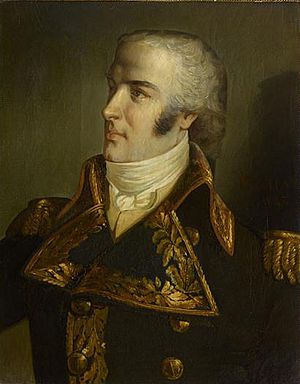Charles René Magon de Médine facts for kids
Quick facts for kids
Magon de Médine
|
|
|---|---|

Portrait of Magon by Antoine Maurin
|
|
| Born | 12 November 1763 Paris |
| Died | 21 October 1805 (aged 41) Trafalgar |
| Allegiance | France |
| Service/ |
Navy |
| Years of service | 1777–1805 |
| Rank | contre-amiral |
| Commands held | frigates Prudente and Vertu, ship-of-the-line Algésiras |
| Battles/wars | American Revolutionary War (Ushant, Chesapeake, St. Kitts, Les Saintes), French Revolutionary Wars (battle of the Black River, Sercey campaign, Saint-Domingue expedition), Napoleonic Wars (Invasion of Britain, Cape Finisterre, Trafalgar) |
| Awards | named on the Arc de Triomphe |
| Signature |  |
Charles René Magon de Médine was a brave French admiral. He was born in Paris on November 12, 1763. He sadly died in battle at Trafalgar on October 21, 1805. He was leading his ship, the Algésiras, during this famous battle.
French historians remember him for his courage. His actions were seen as one of the few good things in that terrible defeat. His name is even carved on the famous Arc de Triomphe in Paris.
Contents
Who Was Charles René Magon?
Charles René Magon came from a noble family in Saint-Malo. He joined the navy in 1777 as a young cadet. His father was a governor of the Mascarene Islands. When his father died in 1778, Charles inherited the Médine estate on Mauritius. This is where he got the "de Médine" part of his name.
Magon fought in the American Revolutionary War. His first battle was Ushant in 1778. He was on the ship Bretagne. Later, he joined the English Channel campaign on the Saint Esprit.
In 1780, he became an ensign. He served in the Antilles on the ship Solitaire. He fought in three battles against the British fleet near Dominica. After that, he joined Admiral de Grasse's squadron. He fought in important battles like the Chesapeake, St. Kitts, and Les Saintes. He was captured by the British but was set free in late 1782.
Serving in the Indian Ocean (1783-1798)
In 1783, Magon sailed to the Indian Ocean. He spent the next 15 years there. He was promoted to lieutenant in 1786. In November 1786, he took command of the frigate Amphitrite. He helped take back Diego Garcia from the British.
After returning, he served as second officer on other frigates. He spent another 18 months sailing near India and China.
Magon During the French Revolution
In 1791, Magon took command of the frigate Minerve. Then, in 1792, he commanded the Cybèle. Because he was from a noble family, he was briefly arrested. But he was quickly released. He then became an aide to the governor-general of the Mascarene Islands.
Battles in the Indian Ocean (1793-1798)
In 1793, Magon commanded the Prudente. His division fought and won against two British ships in October 1794. This battle took place on the Rivière Noire District. He was promoted to captain soon after. He then became the temporary commander of French naval forces in the Indian Ocean.
On the Prudente, he fought in more campaigns. One notable battle was in September 1796. Six French frigates fought against two large British ships. The French frigates did well, but their admiral did not push for a full victory.
In 1798, Magon took command of the Vertu. He helped escort two Spanish ships back to Europe. He fought off attacks from British frigates in Guinea and in July. When he arrived back in Europe, he was rewarded by the Spanish.
He faced some trouble when he returned to Paris. But Admiral Étienne Eustache Bruix helped him. A few months later, Magon was promoted again.
Return to Active Service (1801-1802)
In 1801, Magon returned to active duty. He first served on the ship Océan. Then he was on the Mont-Blanc. This ship was part of a naval force going to Saint-Domingue.
Magon was put in charge of four ships and two frigates. His mission was to capture Fort Dauphin. He did this so quickly and successfully that the commander, Leclerc, immediately promoted him. Magon became a contre-amiral (rear admiral). The government confirmed this promotion in March 1802.
Magon in the First French Empire
In 1803, Admiral Bruix called Magon to Boulogne-sur-Mer. Magon was to command the right side of the fleet. This fleet was being prepared for Napoleon's planned invasion of the United Kingdom.
On December 11, 1803, he became a member of the Légion-d'Honneur. He was promoted within it in 1804. Napoleon ordered the fleet to practice in the open sea. Magon thought this was too dangerous because of bad weather. He was right. A storm destroyed 30 barges. In the following months, Magon successfully defended the fleet from British attacks.
The Battle of Trafalgar (1805)
In March 1805, Magon commanded a division at Rochefort. This included the ships Algésiras and Achille. He joined Admiral Villeneuve in the Antilles.
In July 1805, Magon commanded the rear of the fleet. This was during the Battle of Cape Finisterre. They fought against Admiral Robert Calder's squadron.
In October, Magon fought his twelfth battle at Trafalgar. He was only 42 years old. He was still on the Algésiras. His ship was part of the Spanish admiral Gravina's squadron. This squadron was attacked by Admiral Collingwood's ships.
The crew of the Algésiras was about to board the British ship HMS Tonnant. But then, HMS Colossus and HMS Bellerophon came to help the British admiral. Magon was shot twice but kept fighting. He led the battle for five hours. He was finally killed by a third shot. This happened just before his ship was captured.
Images for kids
See also
 In Spanish: Charles René Magon de Médine para niños
In Spanish: Charles René Magon de Médine para niños

